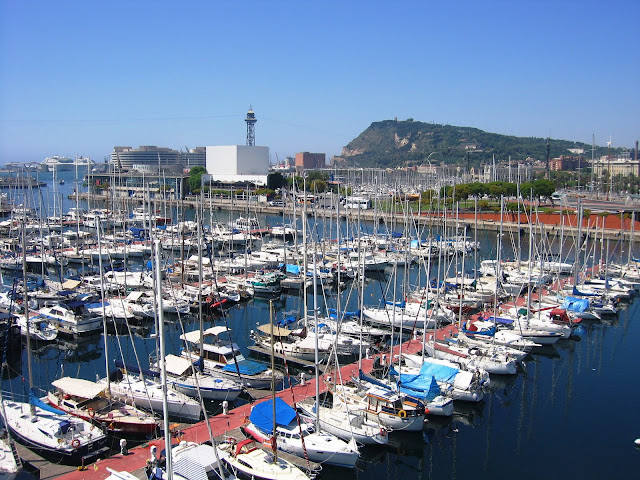Below: An extension of Las Ramblas, newly built, is the Rambla de Mar, a pedestrian walkway leading to the shopping centre Maremagnum, aquarium and IMAX. The statue, inspired by Nelson;s Column in London, is the Monument a Colom (monument to Christopher Columbus) erected for the 1888 Universal Exhibition. Though WHY I am still wondering about; Columbus didn't have anything to do with Barcelona. (2006)


 Below: Barrio Candela prompts by-standers to get dancing (2008)
Below: Barrio Candela prompts by-standers to get dancing (2008) Below: And this young woman sold their CD for €10 (yes, we bought!)
Below: And this young woman sold their CD for €10 (yes, we bought!)
Below: Getting taken for a skate by the dog (2008) Below: Barcelona Head by Roy Lichtenstein. Echoing Barcelona's favourite son, Antoni Gaudi's technique of trencadis tiling - smashing up ceramics and piecing them together, Lichtenstein created this from coloured ceramic tiles (2006)
Below: Barcelona Head by Roy Lichtenstein. Echoing Barcelona's favourite son, Antoni Gaudi's technique of trencadis tiling - smashing up ceramics and piecing them together, Lichtenstein created this from coloured ceramic tiles (2006)

 Below: Port Vell with Montjuïc behind. The Olympic stadium, pool and other facilities are on Montjuïc. (2006)
Below: Port Vell with Montjuïc behind. The Olympic stadium, pool and other facilities are on Montjuïc. (2006) Below: The marina of Port Vell. You can just see the gondola cableway which links Barceloneta and Montjuïc. (2008)
Below: The marina of Port Vell. You can just see the gondola cableway which links Barceloneta and Montjuïc. (2008)
Below: Port Vell. The intermediary cableway station is at the World Trade Centre. The cableway was constructed for the 1929 World Fair. (2008) Below: Port Vell with the pedestrianised Moll de la Fusta, a seaside promenade. (2008)
Below: Port Vell with the pedestrianised Moll de la Fusta, a seaside promenade. (2008) Below: To the right the Palau de Mar, former warehouses, which have now been refurbished to house restaurants and the excellent Museu d'Història de Catalunya (2008)
Below: To the right the Palau de Mar, former warehouses, which have now been refurbished to house restaurants and the excellent Museu d'Història de Catalunya (2008) Below: The Palau de Mar (2006) , the refurbished 19th century warehouse
Below: The Palau de Mar (2006) , the refurbished 19th century warehouse Below: The Museu d'Història de Catalunya covers Catlalunyan history from the Palaeolithic era right up to 1980 and the re-establishment of semi-autonomous Catalunya. It's a fabulous place, a museum of social and political history, with explanations in English and Spanish as well as Catalunyan. Here's a typical 1930s kitchen (2008)
Below: The Museu d'Història de Catalunya covers Catlalunyan history from the Palaeolithic era right up to 1980 and the re-establishment of semi-autonomous Catalunya. It's a fabulous place, a museum of social and political history, with explanations in English and Spanish as well as Catalunyan. Here's a typical 1930s kitchen (2008) Below: A kitchen updated to the 1950s (2008)
Below: A kitchen updated to the 1950s (2008) Below: A typical 1960s bar (2008)
Below: A typical 1960s bar (2008)
Below: Presidential table and chairs from the Palau de la Generalitat de Catalunya (Palace of the Parliament of Catalunya Below: Inside the Museu Marítim, in the old medieval shipyards (Drassanes) , members of the Friends of the Museum make model ships.
Below: Inside the Museu Marítim, in the old medieval shipyards (Drassanes) , members of the Friends of the Museum make model ships.
 Below: The Drassanes, the refurbished shipyard. They used to be right on the sea.
Below: The Drassanes, the refurbished shipyard. They used to be right on the sea. Below: The vaults of the Drassanes, and a reconstruction of La Real, Don Juanse Austria's flagship at the Battle of Lepanto in 1571, in which the Muslim Ottoman Empire was prevented from controlling the Mediterranean.
Below: The vaults of the Drassanes, and a reconstruction of La Real, Don Juanse Austria's flagship at the Battle of Lepanto in 1571, in which the Muslim Ottoman Empire was prevented from controlling the Mediterranean.

No comments:
Post a Comment